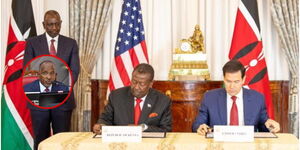The Central Bank of Kenya (CBK) on Wednesday, May 3, launched a Kenya Quick Response Code (KE QR CODE) payment system to be used by businesses across the country including supermarkets, general stores, shops and other outlets.
In a statement, CBK noted that the new payment interface will allow one to send money to an individual, or a business by simply scanning a QR code.
The move seeks to accelerate the adoption of cashless transactions and further adopt a quicker and more efficient way of initialising and accepting digital payments across the country.
“Kenya’s Standard QR Code will be known as the Kenya QR Code abbreviated as “KE-QR”.
“The Code will promote customer convenience and security, as well as support future interoperability amongst different payment service provider platforms,” CBK noted in a statement.
How it Works
The QR code consists of black and white squares that contain information that will provide an alternative option for initiating and accepting digital payments at various points of sale.
CBK explained that the information contained by the QR code includes the business name and other unique identifiers including the transaction currency and amount to be paid.
Use of the code will ensure that the privacy of the client is protected because users do not have to share private information including phone numbers, identity numbers or email addresses.
“The codes usually contain the merchant’s information such as the merchant’s business name, unique identifiers for merchants’ payment service providers, and transaction currency and amount.
“With the KE-QR code, where necessary, additional data enrichment fields will be utilised to provide more data on transactions for future data analysis and decision-making purposes,” CBK explained.
The new technology is meant to make digital payment more efficient because users do not have to manually input different payment codes or numbers.
Further, the statement noted that the code could be used by all payment service providers and banks or other financial institutions that it regulates.
“Customers will now be able to make digital payments in an easy, fast, convenient, and secure manner using QR. Previously, customers had to manually input different payment codes and numbers, hence creating friction and cumbersome payment processes that are prone to error.
Warning
Aside from the many benefits of the Kenya Quick Response Code, CBK warned that it posed several risks to the users such as phishing attacks.
Further, the institution stated that it limited acceptance locations, could experience connectivity issues and required adequate consumer training for efficient use.
At the same time, the QR code system could result in a poor consumer journey experience.
However, the regulator outlined measures to mitigate the risks and enhance Kenya's global leadership in digital payment.
"To mitigate these risks, measures such as consumer training, improved payment connectivity, increased QR code acceptance, improved QR code security, and clear data handling policies will be implemented," added CBK.
"With the launch of the QR Standard, Kenya joins other leading markets that have implemented the standardised approach to issuing QR codes for facilitating payments including the Philippines, Jordan, South Africa, Singapore, Bahrain, Saudi Arabia, India, and China,” CBK explained.












